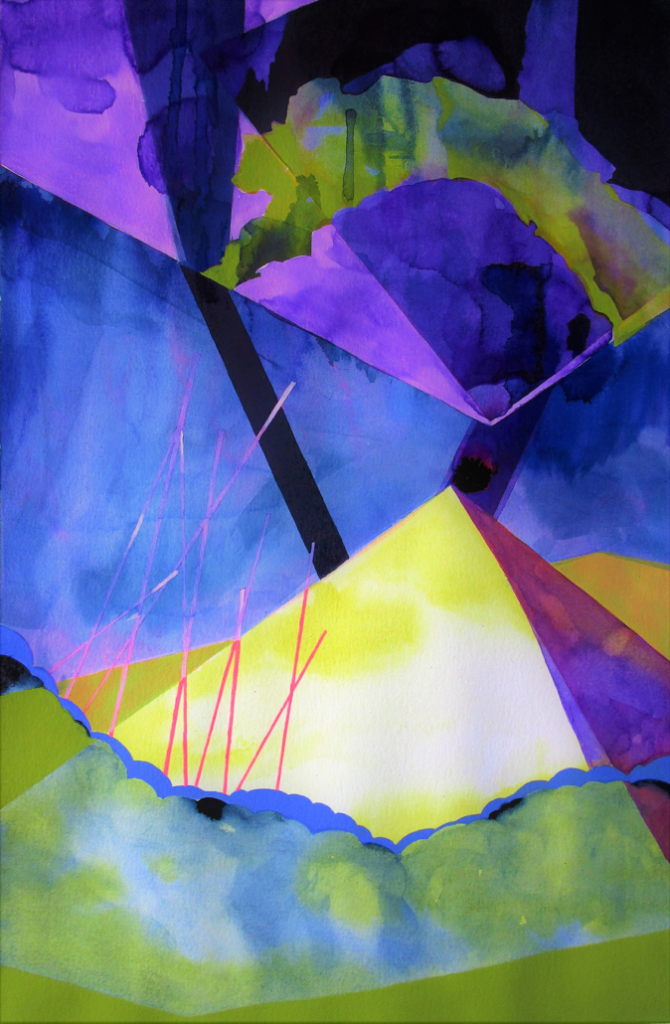Lydia Kinney is one of twelve artists selected as a Gallery 263 Small Works Project artist. This project presents artwork in flat files at the gallery and on our website for the duration of one year. All artists are based in Massachusetts.
Can you tell us a little about yourself?

I’m a painter based in Greenfield, Massachusetts. When I’m not at the studio, I’m at work making picture frames and display cases, at home cooking with my husband, or on the road. I moved back to Western Mass after graduating from Massart in 2014.
What kind of art do you make?
I make paintings and drawings. The work is color, form, and space driven.
What concepts does your art explore?
My work is predominantly about occupying space and environment. In the past year, in almost an inversion to the current State Of Things, the spaces I’m making are bigger, more open, more “outside”, and less defined. I am delighted by spaces that could not make sense. I started with a process of establishing a visual substrate for the physical movement of paint, but over time the two processes have intertwined visually and in their importance. I have also warmed up, recently, to liberally using symbols, with little concern for their connection or connotation of trope. There are many nods to doorways and windows. Sometimes I will borrow the texture of a starry sky but putting it in a silhouette that is almost a house, bringing down beams of dark or fluorescent light from heavy, flat clouds. The space has opened both in depth and in opportunity. It is disheveled, hopeful, sparkling, noncommittal.
Can you tell us about the work you have on view in your flat file drawer at the gallery?
images of work



Most of the work in my flat file is smaller works on paper from the past year. I use layers of acrylic ink, acrylic gouache, colored pencil, and pen. The imagery varies from being very direct—some studies of the interior of my home, but some totally abstracted spaces, and plenty in between.
Where do you make your work?
studio images



I have a cozy, beautiful space in Greenfield’s Web Building, which houses a handful of the valley’s finest artists. I usually only see them in passing, but still feel the buzzing of an environment where the magic is happening. My own space has two windows out to the train tracks and looks out to the hills. Prime sunset viewing.
What are your favorite materials to use? Most unusual?
I love, and have been wrestling with the versatility of, acrylic paint. Just in the time between when I got my bachelor’s and now it seems like the material has come a long way. I love the coverage and liquidity of acrylic ink, and I love the thick matte coverage of acrylic gouache. In the majority of my work, I map out with medium body acrylic and then add/subtract as needed. The most unusual tool is the orbital sander—because I use hard substrates like birch panels, I can work back into it. The sander does not erase the full image, and I’m left to work with the shadow and stains of the marks I worked down. The work on paper is not so forgiving to add and subtract this way, and I have found that my compositional decision making has to be more daring at first.
What historical and contemporary artists inspire you?
My favorite big star big name contemporaries include Carrie Moyer, Sarah Shaw, Adam Lee, and Nick Cave. Lately when I think about my ideal museum trip for The After Times I remember standing in front of a Robert Smithson installation at DIA: Beacon in my birkenstocks and relishing the way it felt vulnerable, inappropriate, confrontational, and natural. That same summer I let the Helen Frankenthaler monotypes at the Clark Museum wreck me entirely.
When did you decide you wanted to be an artist?
I cannot say that there was a singular decision that sent me on this path; art making has always been an innate pastime and means of expression. There are days when I think I would be better at everything I’m committed to if I didn’t put so much of myself into painting. Likewise, there are days I feel I would be a better painter if I did not have to compromise so much of the room in my brain. I think the decision making comes in perpetually finding and recalibrating the balance to be an artist and to live outside of it. The compulsion is too strong and too fundamental for me to ignore.
Is there anything else you would like to share?
It’s so exciting to participate in this project—not just because there’s this drawer of some of my most intimate and precise work sitting in a sun soaked edge of Cambridge alongside some huge talent, but because it feels like a particularly beautiful bridge into the After Times. This past year social media has kept me connected to other artists in ways that are invaluable, and there is a palpable shift towards seeing work in real life that I’m excited to get back into, and actively participate in. It is invigorating to be in the momentum together.